Wallflower: Grow & Care for Erysimum
Written by Iris
Aug 16 2021
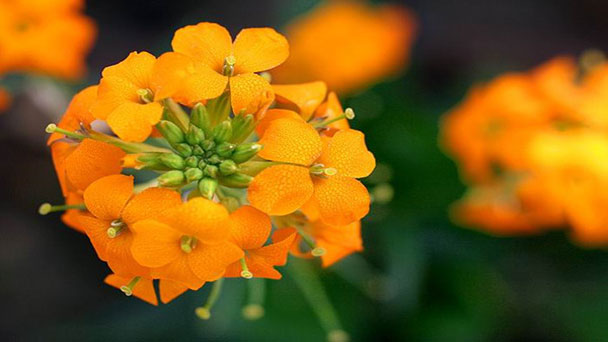
Wallflower (Erysimum) is a family of plants that can be seen in nature as hardy annual, hardy biennial or hardy perennial. Wallflower (Erysimum) can vary in size from 15 centimeters to about one meter. Wallflower (Erysimum)'s leaves are like spears, and Wallflower's (Erysimum) flowers bloom in spring with yellow or orange four-petal flowers. Depending on the species, they can be used in rock gardens or borders.
Make sure, too, that you know what it is you plan to sow. Given space, the colours, and the scents, you need to make sure your intended space can accommodate the plants. Some have large, straight stems that grow quite tall while others are smaller. You can find biennials or perennials, or annuals, depending on what you want to get out of the design.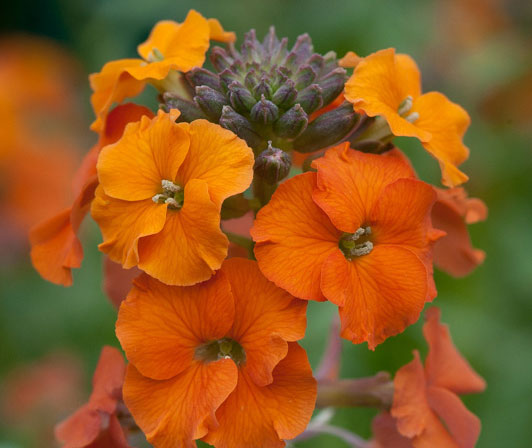
For better results, you should dip the cut end of each stem cutting into a rooting hormone. After this process, plant your Erysimum cuttings in fresh soil or compost. Place the container in a well-lit location. Provide the cuttings with water regularly to maintain the substrate slightly damp. When the cuttings develop a healthy root system, you can transplant them in their permanent spots.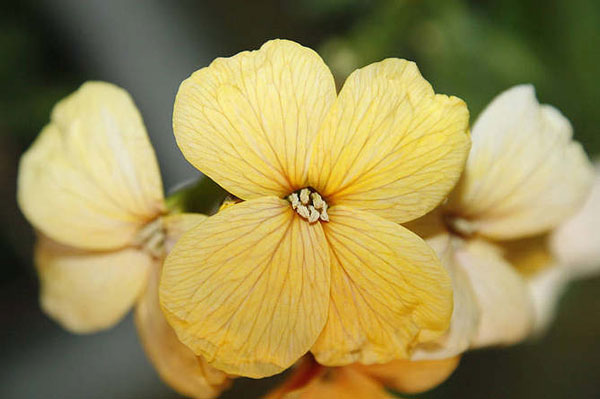
Keep in mind that Wallflowers are susceptible to root rot and do not appreciate having their feet wet. As a general rule, you should water your plants only when their soil has dried out completely. We recommend you check the soil in-between waterings to avoid any soggy conditions.
In terms of humidity, Erysimum plants are quite adaptable and can tolerate a wide range of levels. These flowers can typically handle both dry and moist growing conditions. However, they do not appreciate very high humidity levels, so you should avoid growing them in wet areas of your garden.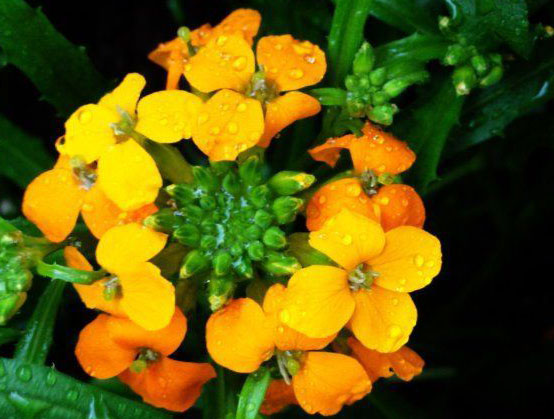
Mature plants should be fine, but they can be a problem with young seedlings; the holes they create are not enough to kill young wallflower plants, but it holds them back several weeks.
If you have trays or rows of young plants, try holding sticky fly paper over the lot, then have someone ruffle the leaves of every plant. The flea beetles hop up on to the paper and stick! You can also try companion planting with a mustard plant, which attracts the flea beetles away from the wallflowers.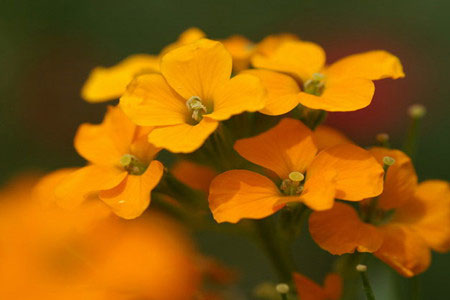
Erysimum 'Fire King' -bears striking orange-red flowers on 16-inch-tall plants. Zones 3-7
Erysimum 'Orange Bedder' -bears bright clusters of orange flowers on compact, 1-foot-tall plants. Zones 3-7
‘Bedding Mixed’ – fragrant, rich blooms in a range of colours including red and yellow appear from spring onwards. For best results sow in May in a nursery bed and plant out in autumn for flowering the following spring
‘Apricot Delight’ – a perennial wallflower, this is a beautiful and floriferous, woody-stemmed small evergreen shrub. The apricot-orange flowers on tall spires, appear for months on end and is a magnet for bees and butterflies
‘Sunset Purple’ – produces fragrant, rich purple blooms in spring, and often, a second flush in late summer. For best results sow in May in a nursery bed and plant out in autumn to flower the following spring
‘Bowles’s Mauve’ – a beautiful, floriferous, woody-stemmed perennial wallflower. It produces masses of pretty mauve flowers on tall spires, for months on end, and in warm, sheltered gardens will flower all year round
‘Winter Orchid’ – a perennial variety that flowers prolifically all year round, and is also sweetly scented. Flowers are a mix of orange and purple, so they really brighten up the winter months with their cheery blooms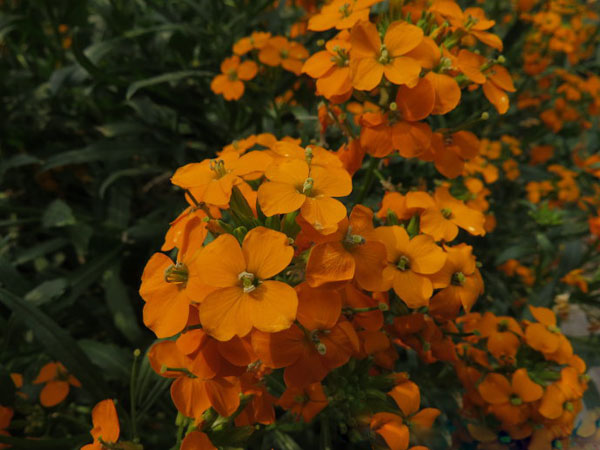
How to Choose and Prepare a Planting SiteWhen to Grow Wallflower (Erysimum)How to Grow Wallflower (Erysimum)How to Care for Wallflower (Erysimum)Varieties of Wallflower (Erysimum)Wallflower (Erysimum) FAQ
How to Choose and Prepare a Planting Site
Before you start growing your wallflowers from seeds, planting bare root wallflowers, or potted perennials, not forgetting the annuals you buy in bedding trays, figure out where you want to plant them. There are many varieties that make for delightful backdrops to a garden bed or line central garden paths in cottage themed gardens. The smell, as you make your way through the wallflower area, will prove well worth the effort. The most successful cultivation will include at least 15 plants of different types, intermixed. This gives more variety and aesthetic appeal to the garden.Make sure, too, that you know what it is you plan to sow. Given space, the colours, and the scents, you need to make sure your intended space can accommodate the plants. Some have large, straight stems that grow quite tall while others are smaller. You can find biennials or perennials, or annuals, depending on what you want to get out of the design.
When to Grow Wallflower (Erysimum)
Sow seeds undercover in February-March, or sow outside in April-May. Young plants can be moved to their final position in late-summer and early autumn to flower the following year.
How to Grow Wallflower (Erysimum)
Steps for Wallflower (Erysimum) Propagation with Seeds
Sowing seeds is a great method to propagate Erysimum plants. You can either sow the seeds outdoors directly into the garden or start them indoors in containers. Wallflowers seeds will germinate faster if you plant them in early spring or late fall. With lots of sunlight and constant moisture, the seedlings will usually show up in several weeks.Steps for Wallflower (Erysimum) Propagation with Cuttings
If you want to use cuttings in this process, you must first look for healthy stems on your mature Wallflowers. Once you have spotted the most attractive stems, cut about 2-3 inches (5-8 cm) off them in late spring. Make sure you remove all leaves from the bottom half of each stem and leave only 3-4 leaflets on the upper half. Moreover, pinch off any blossoms and flower buds.For better results, you should dip the cut end of each stem cutting into a rooting hormone. After this process, plant your Erysimum cuttings in fresh soil or compost. Place the container in a well-lit location. Provide the cuttings with water regularly to maintain the substrate slightly damp. When the cuttings develop a healthy root system, you can transplant them in their permanent spots.

How to Care for Wallflower (Erysimum)
Light
If you plan to grow wallflowers in a garden bed, you can grow them in full sun. This will generate the best results. You can find a few that tolerate light shade if there are no fully sunny areas in your garden. Many wallflowers are flexible in that they tolerate poor soils, so even bad soil won’t need to be severely altered with the exception of making sure it's free-draining by mixing some grit into the soil.Soil
Moist, well-drained soil is best for wallflowers. If you have heavy clay soil, add grit to the planting hole to improve drainage. They can survive in quite poor conditions and can be seen growing out of stone walls in cottage gardens – it's from this they were given the common name of wallflowers.Water
Like most species of shrubs, Erysimum plants are tolerant of drought for long periods. This particular feature makes them ideal for beginner, busy, or forgetful gardeners. In fact, these flowers can grow just fine only with regular moisture from rainwater. Yet, if you live in a region with infrequent rainfalls, you may need to provide your shrubs with water from time to time.Keep in mind that Wallflowers are susceptible to root rot and do not appreciate having their feet wet. As a general rule, you should water your plants only when their soil has dried out completely. We recommend you check the soil in-between waterings to avoid any soggy conditions.
In terms of humidity, Erysimum plants are quite adaptable and can tolerate a wide range of levels. These flowers can typically handle both dry and moist growing conditions. However, they do not appreciate very high humidity levels, so you should avoid growing them in wet areas of your garden.

Temperature and Humidity
Wallflowers require warm temperatures in order to grow evergreen. They are hardy in U.S. zones 6-9 but can overwinter in areas with colder climates as well. They are very adaptable and can tolerate both dry and moist growing conditions.Fertilizer
Wallflowers don’t need any extra food. However, newly planted wallflowers can be mulched with a 5cm (2in) layer of mushroom or garden compost to help retain moisture in the soil and suppress weeds.Pruning
No specific care is required, but, to boost flower-bearing, remove wilted flowers often. If your wallflower starts spreading too far, simply pull a portion of it out – but don’t do this when seeds are about to fall or you’ll be sowing a trail of wallflowers behind you.Pests and Diseases
Flea beetle is a pin-head-sized, shiny, black beetle, which hops about like a flea. You’ll know flea beetles are feasting on your wallflowers if the leaves are peppered with small holes.Mature plants should be fine, but they can be a problem with young seedlings; the holes they create are not enough to kill young wallflower plants, but it holds them back several weeks.
If you have trays or rows of young plants, try holding sticky fly paper over the lot, then have someone ruffle the leaves of every plant. The flea beetles hop up on to the paper and stick! You can also try companion planting with a mustard plant, which attracts the flea beetles away from the wallflowers.

Varieties of Wallflower (Erysimum)
'Bowles Mauve' -a classic variety with gray-green leaves, pale purple flowers, and a pleasant fragrance. Zones 6-10Erysimum 'Fire King' -bears striking orange-red flowers on 16-inch-tall plants. Zones 3-7
Erysimum 'Orange Bedder' -bears bright clusters of orange flowers on compact, 1-foot-tall plants. Zones 3-7
‘Bedding Mixed’ – fragrant, rich blooms in a range of colours including red and yellow appear from spring onwards. For best results sow in May in a nursery bed and plant out in autumn for flowering the following spring
‘Apricot Delight’ – a perennial wallflower, this is a beautiful and floriferous, woody-stemmed small evergreen shrub. The apricot-orange flowers on tall spires, appear for months on end and is a magnet for bees and butterflies
‘Sunset Purple’ – produces fragrant, rich purple blooms in spring, and often, a second flush in late summer. For best results sow in May in a nursery bed and plant out in autumn to flower the following spring
‘Bowles’s Mauve’ – a beautiful, floriferous, woody-stemmed perennial wallflower. It produces masses of pretty mauve flowers on tall spires, for months on end, and in warm, sheltered gardens will flower all year round
‘Winter Orchid’ – a perennial variety that flowers prolifically all year round, and is also sweetly scented. Flowers are a mix of orange and purple, so they really brighten up the winter months with their cheery blooms

Wallflower (Erysimum) FAQ
why is my wallflower dying?
A very wet and cold winter might impact wallflowers, or new shoots in early spring may be singed by frost. If there is still life in the plant, pinch off the tips or cut back to encourage new growth. If you anticipate extremely cold or wet weather, cover the plants with horticultural fleece or a cloche.What can I do with old wallflowers?
You can lift spent biennial wallflowers planted as bedding and compost them. If you deadhead regularly, it will help prolong the flowering period.Do slugs eat wallflowers?
Slugs don't seem particularly interested in wallflowers.
Latest Updated
- Benefits of Bugleweed - 7 Science-backed Health Benefits
- Bugleweed Dangers & Side Effects - Is It Poisonous?
- How to Plant Evergreen Trees - What You Should Know
- When to Plant Evergreens - Grow Guide for Evergreen Trees
- 12 Wonderful Evergreen Shrubs for Your Garden
- 12 Popular Evergreen Plants with Pictures for Beginners
- When And How To Prune A Lilac Bush Like a Pro
- How to Grow & Care for Lilac Vine (Hardenbergia Violacea)
- Japanese Lilac Tree (Syringa Reticulata) Care & Propagation Guide
- Shumard Oak Pros and Cons - What to Know
Popular Articles
- Winter maintenance of Antirrhinum Majus
- How to Grow Terminalia Mantaly Tree
- How to Grow and Care for Crossostephium Chinense
- How to grow Antirrhinum Majus in spring
- Peristeria Elata (Dove Orchid) Profile: Info & Care Guide
- Underwatered Snake Plant (Sansevieria Trifasciata) - Signs And How To Fix
- How to Care for Brazilian Jasmine Plant (Mandevilla Sanderi)
- How to Grow & Care for Graptopetalum Purple Delight in Summer
- Rosa Chinensis (China Rose): Plant Growing & Care Tips
- How to Care for Baby Sun Rose (Aptenia Cordifolia)